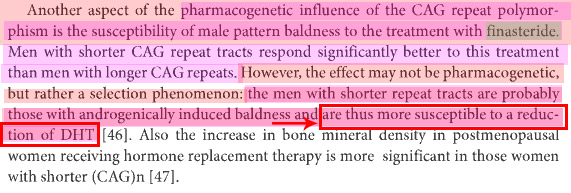Although this is related to prostate cancer, it may shed light at the genetic level as to why we could have reacted poorly to the drug – ie, certain genetic variances/mutations/alleles present in 5AR-II are more responsive to Finasteride than others…
Pharmacogenetic analysis of human steroid 5 reductase type II: comparison of finasteride and dutasteride
jme.endocrinology-journals.org/cgi/content/full/34/3/617#T1
Selected bits: (recommend you read full article!)
INTRODUCTION
"…We have reported significant genetic and pharmacogenetic variation for both finasteride and dutasteride at the SRD5A2 locus in both somatic prostate cancer tissue and constitutional DNA of prostate cancer patients (Makridakis et al. 2000, 2004). Some of these SRD5A2 mutations resulted in increased enzyme activity and lowered inhibition by finasteride (Makridakis et al. 2000, 2004).
These findings suggest that the presence of specific SRD5A2 mutants that are not efficiently inhibited by finasteride may, at least partially, explain the unexpected finding of an increase in high grade prostate cancer rate in the PCPT (reported by Thompson et al. 2003) since these mutants might result in more aggressive growth of tumors. "
RESULTS:
"…[b]The steroid 5-reductase variants that resulted in time-independent inhibition affect enzyme residues in both the amino-terminus and the carboxy-terminus of the protein (residues 49, 118, 226, 227 and 234; Fig. 1), and include the A49T, a gain-of-function mutation in the enzyme (Makridakis et al. 1999) that has been associated with both predisposition and progression of prostate cancer "
…“However, two of the enzyme variants do not follow this trend: the F194L variant (independently of reaction time) and the P48R variant (but only in the 10-min reaction) display lower apparent Ki (higher affinity) for finasteride [/b]than dutasteride’.”
DISCUSSION:
"… The PCPT trial reported that finasteride treatment in men followed over seven years resulted in a significant decrease in the overall rates of prostate cancer, but also in a significant increase in the rates of high-grade prostate tumors (Thompson et al. 2003).
This unexpected finding of an increase in high grade prostate cancer rate in the PCPT may, at least partially, be explained by the presence of specific SRD5A2 variants (like A49T) in a subset of the study population that are not efficiently inhibited by finasteride. For individuals carrying the A49T allele, dutasteride might have been a better choice (Table 2 versus Table 1).
[Size=4]Thus, future trials such as the PCPT and treatment protocols using 5-reductase inhibitors should consider genotyping men for SRD5A2 variants[/size]. In fact, we note that the pharmacogenetic inhibition increases for finasteride with time (Table 1) while it decreases for dutasteride (Table 2).
This may suggest that dutasteride has a ‘tighter’ range for allelic and somatic variants, which may lessen the still considerable impact of pharmacogenetic variation in vitro. Thus, this compound may be generally better tolerated in vivo as well. "
"…However, several 5-reductase variants resulted in time-independent inhibition: (a) the A49T and F118 L variants for finasteride, and (b) the A49T, L226P, R227Q and F234 L variants for dutasteride (Fig. 1, Tables 1 and 2).
These enzyme variants affect residues in both the amino-terminus and the carboxy-terminus of the protein (Fig. 1). Comparison of the wild-type versus mutant residue at positions 49, 118, 226, 227 and 234 indicates that the mutant residues are less hydrophobic. Indeed, the average hydropathy index (Kyte & Doolittle 1982) for residues 49 and 118 (for finasteride) is +2.3 for the wild-type residues and +1.5 for the mutant residues.
Thus, hydrophobic interactions between the 4-azasteroid (finasteride/dutasteride) and specific wild-type 5-reductase residues may be important for the slow, time-dependent inhibition displayed by these inhibitors."
"… In summary, our systematic analysis of both constitutional and somatic (prostate cancer) variants of steroid 5-reductase type II indicates that dutasteride is a more efficient steroid 5-reductase type II inhibitor than finasteride in vitro for most of the enzyme variants, and that dutasteride treatment is also expected to result in lower pharmacogenetic variation in vivo than finasteride treatment.
However, the pharmacogenetic variation we uncovered for both finasteride and dutasteride is still very significant and this should be taken into account when designing protocols for treatment and/or chemoprevention of prostatic diseases with either one of these drugs[.
Our data also suggest that both finasteride and dutasteride are slow, time-dependent inhibitors of steroid 5-reductase type II and allow us to map areas of the wild-type enzyme that are (at least partially) responsible for this time-dependent inhibition for either (or both) enzyme inhibitor(s).
Pharmacogenetic analyses such as the one presented here may one day help in achieving individualized prostate cancer treatment (and perhaps even prevention)."

